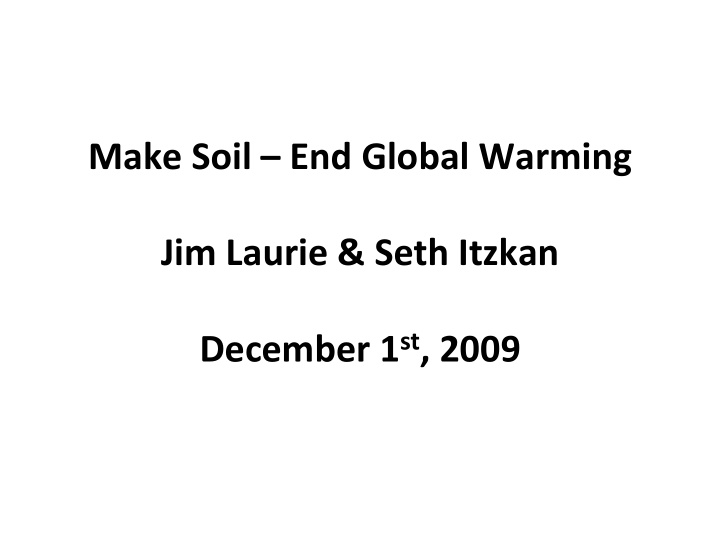



Make Soil – End Global Warming Jim Laurie & Seth Itzkan December 1 st , 2009
Gold Mine Tailings ‐ Austin, Nevada
Animal Impact ‐ Jerrie Tipton 600 Cattle x 4 Days
Tony Tipton ‐ “Gardeners of Eden” Nov 1989 ‐ 32 tons hay on 10 acres Spring 1990 with < 2 inches of winter rain Fall 1990 ‐ Tony Tipton in belt ‐ high grass
Steps to Extinction: Ocean Can’t Breathe Peter Ward ‐ Scientific American 2006 9 UV radiation kills 8 H 2 S destroys ozone remaining life shield
Under a Green Sky ‐ 2007 “CO2 is the driver of extinction episodes.” Peter Ward, UWash Paleontologist, now sees our present dilemma similar to most past extinctions.
Extinction Episode ‐ Now ? Indicators of Imminent Extinction Episode 1. Loss of Ice ‐ Polar and Glacial √ 2. Soil Loss >> Rivers Muddy >> Oceans √ 3. Ocean Dead Zones are Increasing √ 4. Loss of Biodiversity or Desertification √ 5. Ocean Anoxia and H 2 S Fumes ^ ?
Gulf of Mexico Dead Zone 2008 Dead Zone: 7,988 sq miles or the size of Massachusetts!
Namibia ‐ Rotten Egg Smell on Coast ! Namibia is very sparsely populated and has little pollution. Why H 2 S here? What has changed?
Namibia ‐ 200 mile H 2 S plume ! Sardines have been fished out by European trawlers. Algae blooms from Antarctic current upwellings aren’t being converted to proteins and oils to feed big fish. Big fish have since left the area. (California Sardine loss is similar.)
DC Coal Protests – 350 or Farther?
How do we get to 350? Or 300?
Mississippi Watershed Soil loss leads to dead zones
200 GT of Carbon into Grassland Soils Averaging 20 tons sequestered per acre on 10 billion acres, it could be done in 20 to 40 years. 2030 or 2050 ? 1 ppm atmospheric CO2 contains 2 GT of carbon 200 GT C ~ 100 ppm CO2
Buffalo Nation
Prairie Dogs in the Janos Grasslands Prairie dogs are vital to restoring the dwindling grasslands of the Chihuahuan desert. Scientists, in fact, refer to prairie dogs as the architects of North America’s grasslands. Prairie dogs gnaw through woody shrubs such as mesquite that would otherwise takeover the grassland habitat. And as burrowing animals, they excavate tons of hard ‐ baked desert soils, increasing the grounds’ fertility and improving foraging for cattle. http://www.nature.org/wherewework/northamerica/states/newmexico/preserves/art15134.htm l
Perennial Grasses Need to be grazed once or twice per year for a short period (1 day to 1 week) but then have a long recovery time. Fire is rarely a good tool. “95% of terrestrial diversity is in the soil.” to flourish ….. needs cover, carbon from plants, high root biomass. Christine Jones, Australia
West Ranch ‐ Ozona, Texas ‐ 2007 vs. 2002 In 2002, this hill was mostly Prickly Pear cactus and rocks. (above) In July of 2007, Perennial Grasses and Forbs dominate. � � Do you see any Prickly Pear? http://www.sibleynaturecenter.org/essays/mose ying/lavidallanero/070718_holisticranching.html
West Ranch – January 2009 No effort is being made to control Mesquite or Juniper. Fire and chemicals are not used. Perennial Grasses are increasing each year and bare ground is down to 30% from 68% in 2002. Stocking Density is 2.5 times recommended rate. How?
Clear Water and Damsel Flies Clear water is rare in Texas these days. This pond now holds water for several months. Pictures taken at West Ranch in July 2007. (from Sibley Nature Center in Midland, TX)
Cane Bluestem – 2007 West Ranch is managed by Joe & Peggy Maddox using a process called Holistic Management. Wildlife of the ranch is increasing as grass and water increase. www.holisticmanagement.org / www.managingwholes.com Developed by Allan Savory from Zimbabwe and New Mexico, Holistic Management has been successfully used to restore tens of millions of acres of grasslands in Africa, Australia, and the Americas. See: A Global Strategy for Addressing Global Climate Change @ www.savoryinstitute.com
Dung Beetles – West Ranch 2007 Where did the cow patties go? The Maddox operation is certified organic as they don’t use chemicals. Most other ranches in the area have few if any dung beetles. This ground is still largely bare, but the animal impact should encourage perennial grasses. 1 ton of manure can be buried per acre overnight.
Dung Beetles – Pat Richardson
Glomalin may exceed Humus ‐ USDA Is glomalin a way to for fungi to store water for the dry season in brittle environments? It certainly creates structure by gluing soil particles together, creating air spaces for complex food webs in the soil. Fungi and nematodes are critical, earthworms and insects are great! www.sciencedaily.com/releases/20 08/06/080629075404.htm
Shiitake
Mycelium and Glomalin Glomalin may be 30% of healthy soil carbon. Glomalin may be 30% of healthy soil carbon. It can store 10 X it’s weight in water. It can store 10 X it’s weight in water. Photo by Sara Wright (USDA) http://www.sciencedaily.com/releases/2008/06/080629075404.htm
Fungi Mycelium Networks “Soil Brain Tissue” Paul Stamets “Mycelium Running” fungi.com
Recommend
More recommend